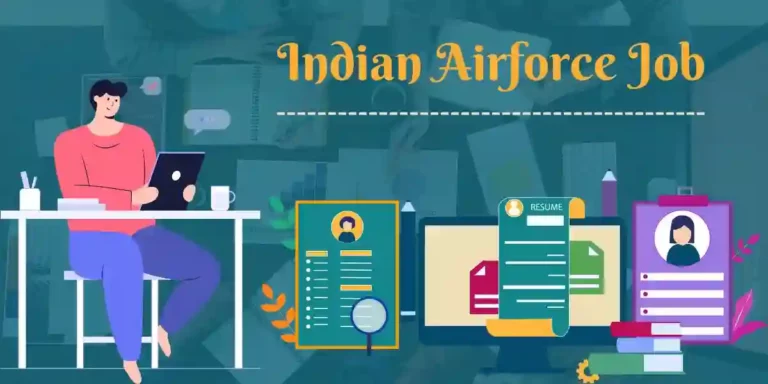India's Largest & Trusted Job Portal
Join As Our Special MemberClick Here
Indian Air Force
Indian Air Force Jobs Notification Are Given Below
Indian Air Force (IAF) invites applications from candidates who have respective qualification to fill vacancies of Agniveer Vayu post through Indian Air Force Agniveer Recruitment 2024 Notification. The candidates who want to get this opportunity can…
Last Date: 22 February 2024, Indian Air Force (IAF-Agnipathvayu) invites applications to fill vacancies of AgniveerVayu (Sports) through Airforce Sports Quota Recruitment 2024 Notification. The candidates who want to get this opportunity can apply through…
Indian Air Force (IAF) invites applications to fill 327 vacancies of AFCAT 01/2024 January 2025) through Air Force AFCAT Exam 01/2024 Notification from 01 December 2023 to 30 December 2023. The candidates who want to…
Last Date: 01 September 2023, "Indian Air Force (IAF)" invites applications from candidates who have qualified respective educational qualifications to fill vacancies of Agniveer Non-Combatant post through "Air Force Non-Combatant Recruitment 2023 Notification". The candidates…
Indian Air Force (IAF) invites applications from candidates who have respective qualification to fill 241 vacancies of AFCAT course through Airforce AFCAT 1/2023 Recruitment 2022 Notification from 01 December 2022 to 30 December 2022. The candidates…
Indian Air Force (IAF) invites applications from candidates who have qualified respective educational qualifications to fill vacancy of Airmen (Y Group) through Air Force Airmen Recruitment 2023 Notification. Candidates who want to take advantage of…
Last Date: 05 January 2023, Indian Air Force (IAF) invites applications from candidates who have respective qualification to fill 108 vacancy of Apprentice through "Indian Air Force Apprentice Vacancy 2022 Notification" from 19 December 2022…
Indian Air Force (IAF) invited applications from interested candidates to fill the vacant posts through "Indian Airforce AFCAT 2/2022". The result of the exam has been issued. Desirous candidates who have applied for recruitment can…
Last Date: 15 August 2022, "Indian Air Force (IAF)" invites applications from candidates who have qualified respective educational qualifications to fill 152 vacancies of Apprentice (Technical Trades) Post through "Air Force Chandigarh Apprentice Vacancy 2022 Notification"…
Last Date: 31 July 2022, "Indian Air Force (IAF)" invites applications from candidates who have respective qualification to fill 21 vacancies of Group C Post through "Air Force Group C Recruitment 05/2022 Notification" from 02…
Last Date: 17 July 2022, "Indian Air Force (IAF)" invites applications from candidates who have respective qualification to fill 15 vacancies of Group C Post through "Air Force Group C Recruitment 2022 Notification". The candidates…
Last Date: 20 June 2022, The Indian Air Force (Ministry of Defence) invites applications from candidates who have the respective educational qualifications to fill 04 vacancies in Lower Division Clerk (LDC) posts through the "Indian…
Last Date: 16 January 2022, The Indian Air Force (IAF) applications from candidates who have respective qualification to fill 05 vacancies of Cook through "Indian Air Force Cook Offline Form 2021-22 Notification". Any candidate who…
Last Date: 28 November 2021, "Indian Air Force (AIF)" has invited applications from candidates to fill the vacant posts through "Air Force Group C Recruitment 05/2021". Whatever candidates want to get the opportunity of service…
"Indian Air Force (AIF)" had invited applications from interested citizens to fill the vacant posts through "Indian Air Force Group C Recruitment 2021". Written examination was conducted to fill the vacant posts. The result of…
"Indian Air Force (IAF)" had invited applications from interested citizens to fill the vacant posts through "Indian Air Force AFCAT 02/2021 Admit Card". Written examination was conducted to fill the vacant posts. The result of…
Last Date: 19 September 2021, "Indian Air Force (AIF)" has invited applications from candidates to fill the vacant posts through "Air Force Group C Recruitment 04/2021". Whatever candidates want to get the opportunity of service…
Last Date: 05 September 2021, "Indian Air Force (AIF)" has invited applications from candidates to fill the vacant posts through "Air Force Group C Recruitment 2021". Whatever candidates want to get the opportunity of service…
Last Date: 22 August 2021, "Indian Air Force (AIF)" has invited applications from candidates to fill the vacant posts through "Indian Air Force Group C Civilian Recruitment 2021". Whatever candidates want to get the opportunity…
India's Largest & Trusted Job Portal Join As Our Special MemberClick Here TITLE :- Indian Air Force AFCAT 02/2020 Result POST DATE :- 20 October 2020 SHORT INFO :- “Indian Air Force (IAF)” invited applications…
India's Largest & Trusted Job Portal Join As Our Special MemberClick Here TITLE :- Indian Air Force X Y Group 01/2021 Recruitment 2020 | Result, Phase II Admit Card POST DATE :- 30 November 2020…
Through Indian Air Force Rally Recruitment Online Form 2020, Indian Air Force (IAF), applicants have been invited to apply for the following posts:
"Indian Air Force (IAF)" had invited applications from interested citizens to fill the vacant posts through "Indian Air Force UP Delhi MP Bihar Rally 2020". Written examination was conducted to fill the vacant posts. The…
"Indian Air Force (IAF)" had invited applications from interested citizens to fill the vacant posts through "Indian Air force AFCAT Entry 01/2021". Written examination was conducted to fill the vacant posts. The result of which…
"Indian Air Force (IAF)" had invited applications from interested citizens to fill the vacant posts through "Indian Air Force AFCAT 01/2020". Examination was conducted to fill the vacant posts. The Selection List of which has…
"Indian Air Force (IAF)" invited applications from interested candidates to fill the vacant posts through "Indian Air Force X Y Group Recruitment 01/2022". The dates of the exam has been issued. Desirous candidates who have…
Last Date : 25 June 2021, "Air Force School, Gwalior (MP)" has invited applications from candidates to fill the vacant posts through "Air Force School Gwalior Recruitment 2021". Whatever candidates want to get the opportunity…
